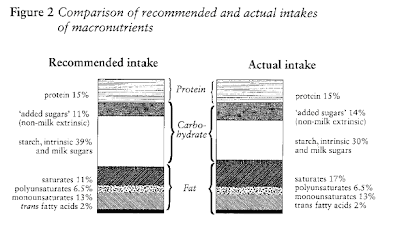It is based on the Report of the Panel on Dietary Reference Values, Committee on Medical Aspects of Food Policy (COMA), Dietary Reference Values for Food Energy and Nutrients for the United Kingdom.
In the diagram below, ‘Actual intake’ is derived from The Dietary and Nutritional Survey of British Adults (Gregory et al., 1990) - for foods eaten outside the home! (More details of the food surveys and their impact will be coming up in future blogs.)

In the later survey,
"the ‘Eating Out’ diary was intended to be used only when it was not possible to weigh the food items. In such cases, respondents were asked to write down as much information as possible about each food item consumed, particularly the
portion size and an estimate of the amount of any left over."
How scientific is that? And the recommendation that accompanies the diagram?
“In terms of foods, the UK population needs to increase its consumption of fibre-rich starchy foods such as bread, potatoes, rice and pasta, as well as
fruit and vegetables, by at least half as much again”.
Yeah, right! I know what happened when I tried just that - I put on five stone!
One of the real gems I discovered in Scientific Basis of Nutrition Education was this:
Energy intakes have been declining over a number of years and are currently below the EAR (Estimated Average Requirements). Despite this, the number of men and women respectively who are overweight or obese has increased from39% and 32% in 1980 to 45% and 36% in 1987 (Gregory et al., 1990) and to 57% and 48% in 1993 (Bennet et al., 1995). This increase in an indication of a growing public health problem, and one which can only be tackled by further restricting energy intake or preferably increasing physical activity – or a combination of the two
So let’s recap on that; the number of people who are obese/overweight goes up at the same time as calorie intake goes down. And the experts’ solution is to reduced calories further?? HUH? It almost beggars belief!
Another nugget I discovered among its pages concerns saturated fat. Current Government guidelines say that 11% of total calorie intake should be saturated fat, but that on average consumption is 20% higher. By my reckoning that's 13.2% current consumption, right?
According to Scientific Basis of Nutrition Education, MAFF (Ministry of Agriculture Fisheries and Food) gave the average consumption of saturated fat in 1995 as 16%, and falling slowly.
So, saturated fat consumption is falling, yet more of the population is becoming obese.
Does it really look as if sat-fat is the problem??



Well when you put it like THAT Megan!! Very interesting reading yet again. Lol Lynn ♥
ReplyDelete